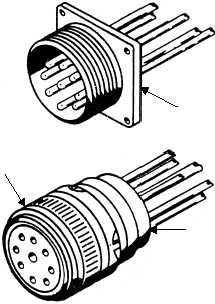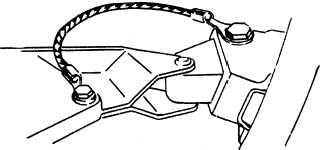assemblies are coupled by means of a coupling nut.
Each consists of an aluminum shell containing an
insulating
insert
that
holds
the
current-carrying
contacts. The plug is usually attached to the cable end,
and is the part of the connector on which the coupling
nut is mounted. The receptacle is the half of the
connector to which the plug is connected. It is usually
mounted on a part of the equipment. One type of
connector commonly used in aircraft electrical systems
is shown in figure 5-19.
TERMINALS
Since most aircraft wires are stranded, it is
necessary to use terminal lugs to hold the strands
together. This allows a means of fastening the wires to
terminal studs. The terminals used in electrical wiring
are either of the soldered or crimped type. Terminals
used in repair work must be of the size and type
specified in the applicable maintenance instruction
manual. The crimped-type terminals are generally
recommended for use on naval aircraft. Soldered-type
terminals are usually used in emergencies only.
The basic types of solderless terminals are shown
in figure 5-20. They are the straight, right angle, flag,
and splice types. There are variations of these types.
BONDING
When you connect all the metal parts of an aircraft
to complete an electrical unit, it is called bonding.
Bonding connections are made of screws, nuts,
washers, clamps, and bonding jumpers. Figure 5-21
shows a typical bonding link installation.
An aircraft can become highly charged with static
electricity while in flight. If the aircraft is improperly
bonded, all metal parts do not have the same amount of
static charge. A difference of potential exists between
the various metal surfaces. If the resistance between
insulated metal surfaces is great enough, charges can
accumulate. The potential difference could become
high enough to cause a spark. This constitutes a fire
hazard and also causes radio interference. If lighting
strikes an aircraft, a good conducting path for heavy
current is necessary to minimize severe arcing and
sparks.
Bonding
also
provides
the
necessary
low-
resistance
return
path
for
single-wire
electrical
systems. This low-resistance path provides a means of
bringing the entire aircraft to the earth's potential when
it is grounded.
5-14
ANF0519
RECEPTACLE
ASSEMBLY
COUPLING
NUT
PLUG SOCKET
ASSEMBLY
Figure 5-19.—Connector assembly.
ANF0520
TOUGUE
BARREL
TERMINAL
HOLE
STRAIGHT
RIGHT ANGLE
FLAG
SPLICE
Figure 5-20.—Basic types of solderless terminals.
ANF0521
Figure 5-21.—Typical bonding link installation.






